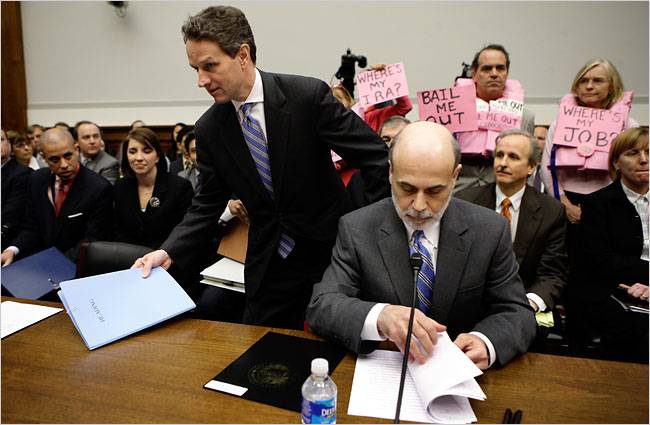

I will have more later. Please enjoy both videos. This transcript is from Tech Ticker.
Tim Geithner has finally revealed his plan to fix the banking system and economy. Paul Krugman, James Galbraith, and others have already trashed it.
[We spoke with noted economist Galbraith this morning. In the accompanying segment, he calls the Treasury Secretary’s plan “extremely dangerous.”]
Why?
In short, because the plan is yet another massive, ineffective gift to banks and Wall Street. Taxpayers, of course, will take the hit.
Why does Tim Geithner keep repackaging the same trash-asset-removal plan that he has been trying to get approved since last fall?
In our opinion, because Tim Geithner formed his view of this crisis last fall, while sitting across the table from his constituents at the New York Fed: The CEOs of the big Wall Street firms. He views the crisis the same way Wall Street does--as a temporary liquidity problem--and his plans to fix it are designed with the best interests of Wall Street in mind.
If Geithner's plan to fix the banks would also fix the economy, this would be tolerable. But no smart economist we know of thinks that it will.
We think Geithner is suffering from five fundamental misconceptions about what is wrong with the economy. Here they are:
The trouble with the economy is that the banks aren't lending. The reality: The economy is in trouble because American consumers and businesses took on way too much debt and are now collapsing under the weight of it. As consumers retrench, companies that sell to them are retrenching, thus exacerbating the problem. The banks, meanwhile, are lending. They just aren't lending as much as they used to. Also the shadow banking system (securitization markets), which actually provided more funding to the economy than the banks, has collapsed.
The banks aren't lending because their balance sheets are loaded with "bad assets" that the market has temporarily mispriced. The reality: The banks aren't lending (much) because they have decided to stop making loans to people and companies who can't pay them back. And because the banks are scared that future writedowns on their old loans will lead to future losses that will wipe out their equity.
Bad assets are "bad" because the market doesn't understand how much they are really worth. The reality: The bad assets are bad because they are worth less than the banks say they are. House prices have dropped by nearly 30% nationwide. That has created something in the neighborhood of $5+ trillion of losses in residential real estate alone (off a peak market value of housing about $20+ trillion). The banks don't want to take their share of those losses because doing so will wipe them out. So they, and Geithner, are doing everything they can to pawn the losses off on the taxpayer.
Once we get the "bad assets" off bank balance sheets, the banks will start lending again. The reality: The banks will remain cautious about lending, because the housing market and economy are still deteriorating. So they'll sit there and say they are lending while waiting for the economy to bottom.
Once the banks start lending, the economy will recover. The reality: American consumers still have debt coming out of their ears, and they'll be working it off for years. House prices are still falling. Retirement savings have been crushed. Americans need to increase their savings rate from today's 5% (a vast improvement from the 0% rate of two years ago) to the 10% long-term average. Consumers don't have room to take on more debt, even if the banks are willing to give it to them.
The two charts below from Ned Davis illustrate the real problem: An explosion of debt relative to GDP. The first is Nonfinancial Debt To GDP. The second is Total Debt To GDP.
In Geithner's plan, this debt won't disappear. It will just be passed from banks to taxpayers, where it will sit until the government finally admits that a major portion of it will never be paid back.
Part 2 From Tech Ticker
Part II: Geithner, Obama Kowtowing to "Massively Corrupted" Banks, Galbraith Says
Like it or not, many people seem to be resigned to the idea there's no alternative to the public-private investment fund scheme Treasury Secretary Geithner detailed this morning.
That's hogwash, says University of Texas professor James Galbraith, author of The Predator State. Of course there's an alternative: FDIC receivership of insolvent banks.
Aside from being legally proscribed, the upside of FDIC receivership is the banks are restructured and reorganized for potential sale (either in whole or parts), Galbraith says. Such was the fate in 2008 of, most notably, Washington Mutual and IndyMac.
Crucially, FDIC receivership also means new management teams for insolvent banks; and Galbraith notes new leaders will have no incentive to cover up the fraudulent or predatory lending practices of their predecessors. Given the entire system was "massively corrupted by the subprime debacle," the professor believes criminal prosecutions on par with the aftermath of the S&L crisis - when hundreds of insiders went to jail - is a likely (and necessary) outcome of the current crisis.
But don't expect to see many "perp walks" if Geithner's current plan comes to fruition. That's one reason Galbraith called the plan "extremely dangerous" in part one of our interview.
So why isn't the Obama administration pushing for FDIC receivership? "Political influence of big banks," the economist says.